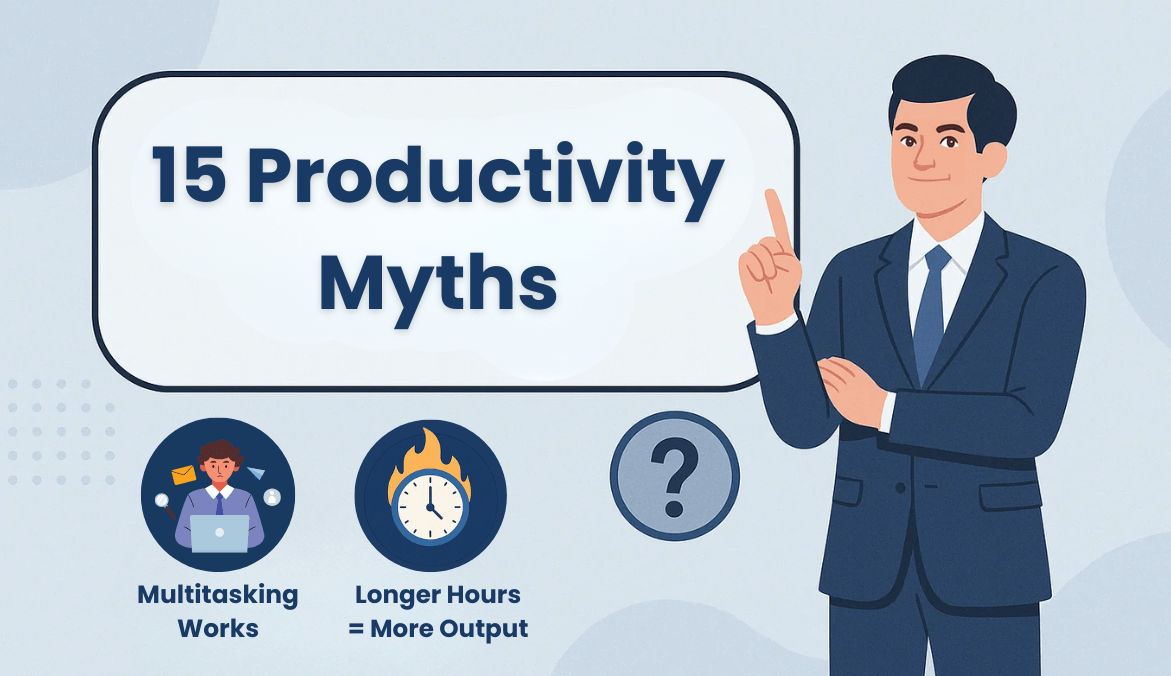Introduction
If I had to list the biggest roadblocks I’ve seen in my 10+ years of leading teams, productivity myths at work would be near the top. They’re sneaky because they sound logical — “work longer and you’ll achieve more” or “if you answer Slack instantly, people will see you as engaged.” But in practice, these myths quietly sabotage teams, burn out high performers, and distort what real progress looks like.
Over the past decade leading distributed teams of 50+ people and mentoring new managers, I’ve seen how fast these myths creep in and derail even the most capable leaders.
This article isn’t just about debunking myths. I’ll show you why leaders keep falling for them, where they backfire, and what to do instead. Think of it as a productivity reset button, based on hard-earned lessons, research-backed truths, and practical fixes you can apply.
The 15 Myths Leaders Still Believe
I’ll admit, I used to fall for a few of these myself. Here’s the quick cheat sheet — keep it handy, but dive into the sections for stories and fixes.
| Myth | Truth | Leader Fix |
|---|---|---|
| Longer hours = more output | Hours ≠ quality | Cap meeting load, track rework |
| Early risers are more productive | Chronotypes differ | Flexible core hours |
| Busyness = progress | Outcomes matter | Weekly outcome reviews |
| Multitasking works | It’s task-switching | Monotasking norms |
| More meetings = alignment | Async > meeting-first | Meeting taxonomy |
| RTO = productivity | Depends on work type | Measure outcomes, not presence |
| Tasks = productivity | Invisible work matters | Redefine KPIs |
| Perfect app fixes focus | Habits > tools | One-tool-per-job rule |
| More tools = faster work | Tool sprawl = friction | Quarterly tool audit |
| Instant replies prove value | Interruptions kill focus | Response SLAs |
| Procrastination = laziness | Often fear/ambiguity | Clarity rituals |
| One routine fits all | People differ | Team guardrails, personal playbooks |
| Leaders must do it all | Delegation = leverage | Do/Delegate/Automate/Drop |
| AI will fix productivity | Needs process change | Narrow, measured rollouts |
| Hard work speaks for itself | Visibility matters | Wins logs, impact briefs |
Why Leaders Fall for Productivity Myths
Most leaders aren’t misguided — they’re just human. We reward what we can see. Long hours? Visible. Meetings? Visible. Slack replies at midnight? Visible.
But I learned the hard way: visibility doesn’t equal value. On one software project, I praised a development team for working late nights and weekends to “deliver faster.” The release hit the deadline… but fatigue led to a surge in bugs and rework. Studies show error rates climb significantly when developers push beyond 50 hours a week — and I saw it play out firsthand.
That’s why these myths thrive. These toxic productivity myths align with our biases (busyness bias, survivor bias) and short-term optics. Breaking them means building new lenses for what real productivity looks like.
15 Productivity Myths, The Truth, and The Fixes
1. Myth: Longer hours = higher output
Truth: Productivity has limits. Once people work beyond 50 hours a week, output plateaus and mistakes rise sharply. Stanford research confirms that long hours lead to steep drops in quality.
Fix: Normalize “lights out” hours. When one of my teams banned late-night emails, weekend bug fixes dropped by 50%.
2. Myth: Early risers are always more productive
Truth: People have different natural body clocks. Some do their best work early in the morning, while others peak later in the day. Forcing everyone into a 5 a.m. routine can actually reduce energy and quality.
Fix: Set a block of shared working hours — for example, 11 a.m. to 4 p.m. — where everyone is available for meetings and collaboration. Outside that window, let team members choose their own start and finish times.
3. Myth: Busyness means progress
Truth: Activity ≠ outcomes. Gallup reports 70% of employees feel “busywork” prevents focus on meaningful goals [Gallup, 2023].
Fix: Run outcome reviews. Ask: “What impact did we create?” not “How many tickets did we close?”
4. Myth: Multitasking is efficient
Truth: Switching between tasks drains focus. Research shows it can cut productivity by up to 40%.
Fix: Batch communication, create focus blocks. When I started monotasking during reviews, my output doubled.
5. Myth: More meetings = alignment
Truth: More meetings can make it look like everyone is aligned, but in reality, key decisions and next steps are often still unclear.
Fix: Use async decision briefs first. One client reclaimed a full day per week by shifting 40% of updates into dashboards.
6. Myth: Return-to-office guarantees productivity
Truth: Gallup’s 2023 survey found hybrid employees are more engaged than fully on-site.
Fix: Track cycle time, not badge swipes. In my remote pilots, clarity and autonomy boosted outcomes more than location.
7. Productivity = number of tasks done
Truth: Some of the most valuable work — like mentoring or process fixes — isn’t task-shaped.
Fix: Update KPIs to include quality and impact. One analyst delivered only three items in a month, but those drove a 12% revenue lift.
8. The “perfect” app will fix focus
Truth: Tools don’t replace habits — they only amplify them.
Fix: Run a tool audit. Trim the stack. When we cut six apps down to three, adoption doubled.
9. Myth: More tools = faster work
Truth: Extra tools often slow people down through context switching.
Fix: Quarterly audits, one tool per category.
10. Myth: Instant responsiveness proves performance
Truth: Being “always on” destroys deep work.
Fix: Create response SLAs (2 hours for Slack, 1 hour for email). My leadership team’s stress scores dropped 18% after adopting this.
11. Myth: Procrastination = laziness
Truth: Most procrastination comes from unclear goals or fear of failure.
Fix: Use clarity rituals. A reframed project brief once unblocked a teammate within hours.
12. Myth: One routine works for everyone
Truth: Productivity is deeply personal.
Fix: Encourage personal playbooks within guardrails. For global teams, staggered work windows improved output.
13. Myth: Leaders must do everything themselves
Truth: Doing it all caps your growth.
Fix: Apply the 4D Framework: Do, Delegate, Automate, Drop. Delegation freed me 6 hours weekly — enough to mentor two new managers.
14. Myth: AI will fix productivity automatically
Truth: Without workflow redesign, AI creates more work.
Fix: Pilot AI for narrow tasks like summaries. Measure time saved before scaling.
15. Myth: Hard work speaks for itself
Truth: Impact often goes unnoticed unless you highlight it.
Fix: Build rituals like wins logs. A brilliant but quiet engineer I managed was finally promoted once we made their impact visible.
How Mera Monitor Helps Leaders Bust Productivity Myths
Debunking myths is only half the journey — the other half is having the right system in place to see reality clearly. That’s where Mera Monitor comes in.
- Myth: Longer hours = output → Mera Monitor tracks active vs idle time so leaders measure engagement, not just clocked hours.
- Myth: Busyness = progress → Dashboards highlight outcomes and patterns, making invisible work visible.
- Myth: Instant responsiveness proves performance → With activity logs and screenshots, you know where focus is going — without enforcing “always-on” culture.
- Myth: More tools = faster work → Centralized insights replace scattered manual checks, reducing tool sprawl.
- Myth: Productivity = number of tasks done → Mera Monitor shows how work is happening, not just what’s being ticked off.
Leaders using Mera Monitor get:
- Transparent visibility into how work happens — without micromanaging.
- Clear metrics for smarter decisions (active time, idle time, productivity trends).
- Team-level patterns to spot bottlenecks, rebalance workload, and prevent burnout.
If you’re serious about moving beyond these common productivity myths and leading with evidence-based productivity, Mera Monitor can give you the clarity you need.
👉 Book a demo with Mera Monitor and start building systems that measure what truly matters.
Closing Note
Once you see these productivity myths debunked, you realize they’re like weeds — if you don’t pull them, they quietly choke progress. The good news? Once you see them for what they are, you can redesign your systems around outcomes, energy, and impact.
I’ve seen entire teams transform simply by letting go of one or two myths. Start small, challenge one myth this month — the compounding effect may surprise you.
 Gift Card ₹999
Gift Card ₹999

